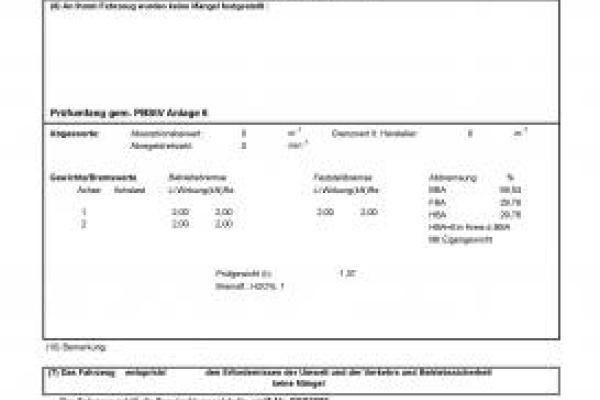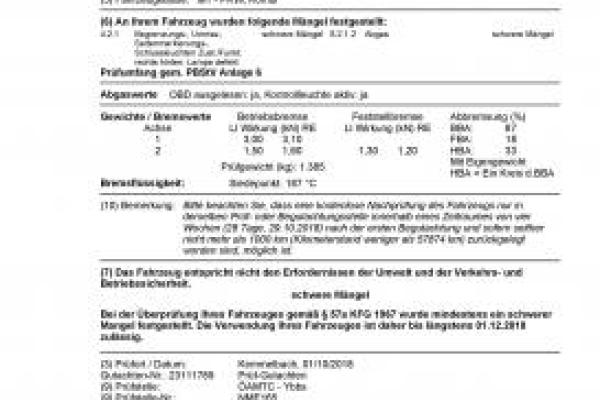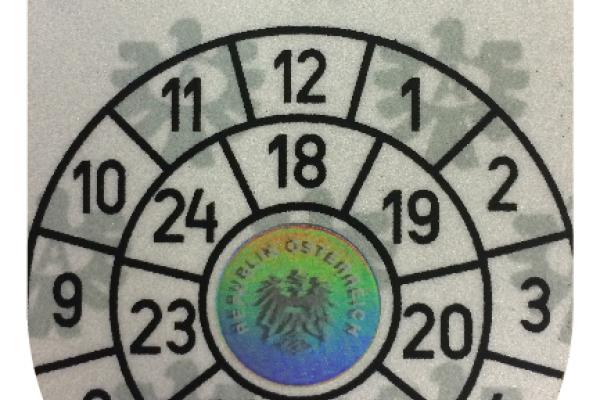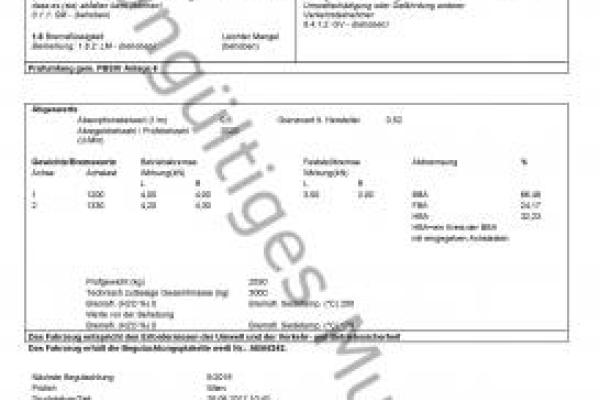General information
General overview
The roadworthiness test is regulated under article 57a of the Austrian Motor Vehicles Act. Defects found during the test are divided into four categories: Minor defects (leichter Mangel, L.M.), which must be rectified; Major defects (schwerer Mangel, S.M.), which must be remedied at the next garage; Dangerous defects (Gefahr im Verzug, G.V.), which must be remedied immediately; Not compliant with regulations (Vorschriftsmangel, V) — the vehicle must not be driven until the defect is corrected. If a vehicle passes the roadworthiness test with no or only minor defects a sticker (Pickerl) is issued as the proof of test. This must be attached to the vehicle so that the bottom edge is no less than 40 cm and its top edge is no more than 190 cm above the road. The sticker shows the month and year when the next test is due. It also includes a serial number and the registration number of the car. The sticker is white. Red stickers with the imprint “HISTORISCHES FAHRZEUG – HISTORIC VEHICLE” are issued for vehicles of historical interest. For vehicles not belonging to following groups a green sticker can be issued: passenger cars, estate cars and trucks up to 3.5 tonnes with a petrol engine and catalytic converter, low-emission vehicles with diesel engines and trailers.
Test frequency
|
Categories or types of vehicles |
First mandatory test |
Subsequent tests |
|
M1, excluding taxis, rescue and ambulance vehicles* |
Within three years after the date of first registration |
Within two years after the first test then every year |
|
Tractors and motor carts with a design speed of more than 25 km/h but no more than 40 km/h* |
Within three years after the date of first registration |
Within two years after the first test then every year |
|
Self-propelled machines and trolleys with a design speed of more than 30 km/h but no more than 40 km/h* |
Within three years after the date of first registration |
Within two years after the first test then every year |
|
Trailers with which a speed of 25 km/h may be exceeded and which have a maximum permissible total weight of no more than 3 500 kg* |
Within three years after the date of first registration |
Within two years after the first test then every year |
|
Agricultural trailers with which a speed of 40 km/h may be exceeded* |
Within three years after the date of first registration |
Within two years after the first test then every year |
|
Agricultural trailers with which a speed of 25 km/h, but not of 40 km/h, may be exceeded* |
Within three years after the date of first registration |
Within two years after the first test then every two years |
|
L* |
Within three years after the date of first registration*** |
Within two years after the first test then every year*** |
|
Vehicles of historical interest* |
Every 24 months |
Every 24 months |
|
All other vehicles (e.g. trucks above or below 3.5 tonnes gross vehicle weight, taxis, rescue and ambulance vehicles, buses and others)** |
Every 12 months |
Every 12 months |
* Flexibility period of one month before and four months after the month in which the test was due to be carried out.
** Flexibility period of three months before the month in which the test was due to be carried out.
*** Before 01/03/2020: Every 12 months
Responsible authorities
Documents are issued by testing bodies authorised by the Austrian Governors of the Federal States (Landeshauptmann), e.g. automobile associations such as ARBÖ and ÖAMTC, commercial enterprises such as garages, freelance civil engineers (Ziviltechniker) and technical or engineering offices and firms (Technische Büros/Ingenieurbüros).
Websites
https://www.oesterreich.gv.at/public.html (German, some parts in English):
https://www.oesterreich.gv.at/themen/freizeit_und_strassenverkehr/kfz/Se...
Major changes
As of 20/05/2018, the flexibility period for carrying out the roadworthiness test of one month before and four months after the relevant date is no longer applicable. Instead the intervals in Article 5 (1) of Directive 2014/45/EU apply. Inspections of category M1 vehicles used as taxis or ambulances and of category M2, M3, N1, N2, N3, O3 and O4 vehicles are annual and a flexibility period of more than one year is not possible. However, the test can now be carried out up to three months before the relevant month.






